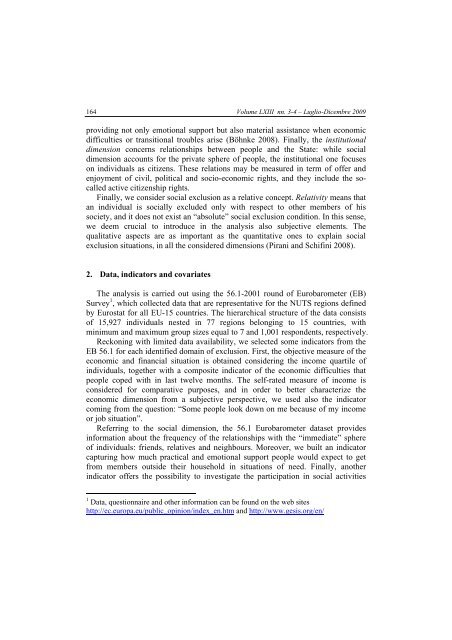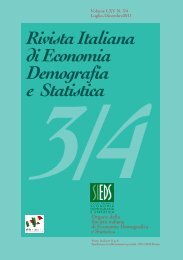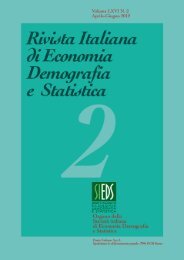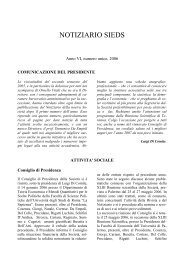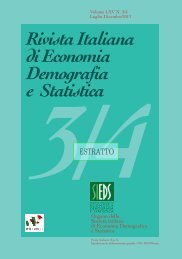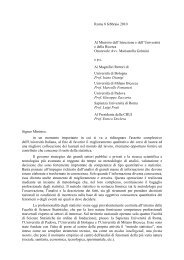rivista italiana di economia demografia e statistica - Sieds
rivista italiana di economia demografia e statistica - Sieds
rivista italiana di economia demografia e statistica - Sieds
Create successful ePaper yourself
Turn your PDF publications into a flip-book with our unique Google optimized e-Paper software.
164<br />
Volume LXIII nn. 3-4 – Luglio-Dicembre 2009<br />
provi<strong>di</strong>ng not only emotional support but also material assistance when economic<br />
<strong>di</strong>fficulties or transitional troubles arise (Böhnke 2008). Finally, the institutional<br />
<strong>di</strong>mension concerns relationships between people and the State: while social<br />
<strong>di</strong>mension accounts for the private sphere of people, the institutional one focuses<br />
on in<strong>di</strong>viduals as citizens. These relations may be measured in term of offer and<br />
enjoyment of civil, political and socio-economic rights, and they include the socalled<br />
active citizenship rights.<br />
Finally, we consider social exclusion as a relative concept. Relativity means that<br />
an in<strong>di</strong>vidual is socially excluded only with respect to other members of his<br />
society, and it does not exist an “absolute” social exclusion con<strong>di</strong>tion. In this sense,<br />
we deem crucial to introduce in the analysis also subjective elements. The<br />
qualitative aspects are as important as the quantitative ones to explain social<br />
exclusion situations, in all the considered <strong>di</strong>mensions (Pirani and Schifini 2008).<br />
2. Data, in<strong>di</strong>cators and covariates<br />
The analysis is carried out using the 56.1-2001 round of Eurobarometer (EB)<br />
Survey 1 , which collected data that are representative for the NUTS regions defined<br />
by Eurostat for all EU-15 countries. The hierarchical structure of the data consists<br />
of 15,927 in<strong>di</strong>viduals nested in 77 regions belonging to 15 countries, with<br />
minimum and maximum group sizes equal to 7 and 1,001 respondents, respectively.<br />
Reckoning with limited data availability, we selected some in<strong>di</strong>cators from the<br />
EB 56.1 for each identified domain of exclusion. First, the objective measure of the<br />
economic and financial situation is obtained considering the income quartile of<br />
in<strong>di</strong>viduals, together with a composite in<strong>di</strong>cator of the economic <strong>di</strong>fficulties that<br />
people coped with in last twelve months. The self-rated measure of income is<br />
considered for comparative purposes, and in order to better characterize the<br />
economic <strong>di</strong>mension from a subjective perspective, we used also the in<strong>di</strong>cator<br />
coming from the question: “Some people look down on me because of my income<br />
or job situation”.<br />
Referring to the social <strong>di</strong>mension, the 56.1 Eurobarometer dataset provides<br />
information about the frequency of the relationships with the “imme<strong>di</strong>ate” sphere<br />
of in<strong>di</strong>viduals: friends, relatives and neighbours. Moreover, we built an in<strong>di</strong>cator<br />
capturing how much practical and emotional support people would expect to get<br />
from members outside their household in situations of need. Finally, another<br />
in<strong>di</strong>cator offers the possibility to investigate the participation in social activities<br />
1 Data, questionnaire and other information can be found on the web sites<br />
http://ec.europa.eu/public_opinion/index_en.htm and http://www.gesis.org/en/


